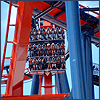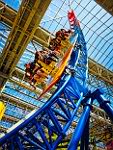However I'm not going to keep saying the same stuff to everyone over and over again, that's why I opened up this thread, if you have a question you can ask me or other members. Note, I am not an expert at this so bear in mind that I can not always answer your questions.
I would also like to add that I will not release any details from Project Phase.
Before you start building I want you to ask yourself this: Is it worth it to start using lights on this project? Electronics are cheap by themselves but a full grown project can cost you tens if not hundreds of dollars.
Wiring up electronics:
Rules for determining Voltage, Ampère and Resistor
Ohms Law:
R = U/I
Series:
Vtotal = V1 + V2 + V3 + ...
Itotal = I1 = I2 = I3 = ...
Example on how to determine the Voltage used and the Resistor Required.
LED at 2.1V and 20mA

12-(5*2.1) = 1.5V
Use Ohms Law:
R = 2.5/0.02
R = 75 Ohms
Best available resistor: 82 Ohms
Parallel:
Vtotal = V1 = V2 = V3 = ...
Itotal = I1 + I2 + I3 + ...
Example Determining Voltage, Current and resistor in Parallel+Series Circuit:
LED at 2.1V and 20mA
Using the info from the previous example, resistors are at 82 Ohms.

Determine the current needed from the power Supply:
3 series in parallel at 20mA per series = 3*20mA = 60mA

Always look up the data sheet for the LED you buy to get the exact values.
Always check how much your power-supply can handle, if the power-supply can not supply the current needed you are going to burn out your power-supply
Always take a resistor higher than the value you calculated.
Take a stabilized power supply if you want your LED's to flash and blink.
Always check how much a light organ kit can handle. If you need more than it can handle you need to start using relays.



























